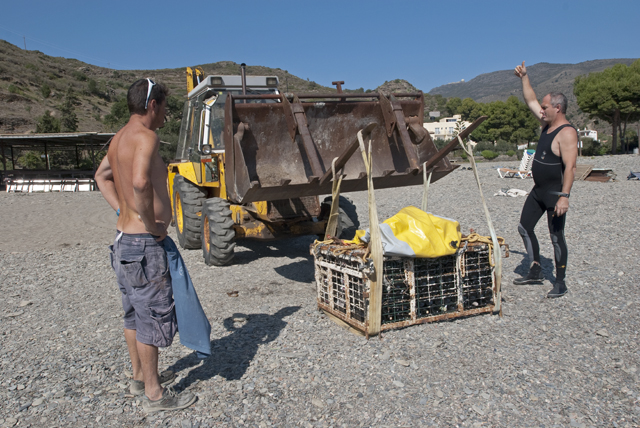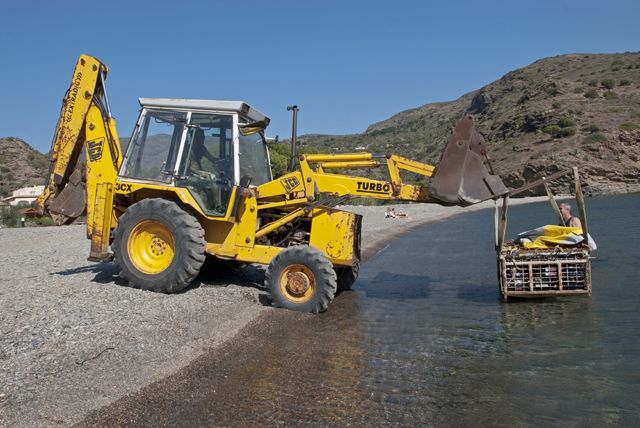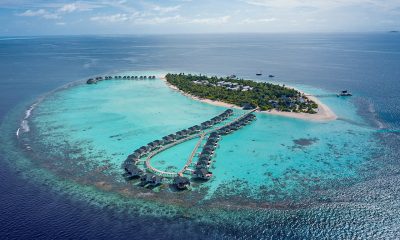News
Wining and Diving in Cala Joncols, Spain
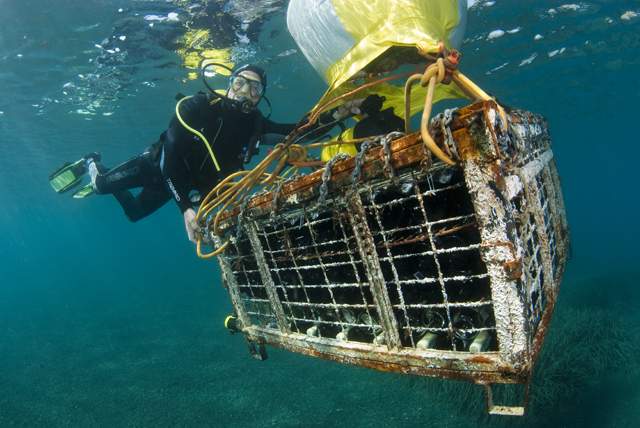
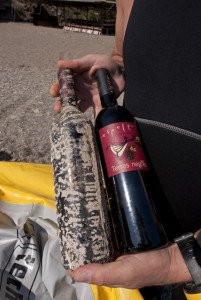 For me, the perfect ending to a full on day’s diving is being surrounded by friends, plenty of wine, eating, chatting and just chilling. During a recent diving holiday to Cala Joncols in Spain I found myself in this very situation with Euro-Divers manager Jan Boelen and his wife Martine. As we polished off the dregs of a surprisingly palatable Grenache Blanc Jan suggested that I should top up with a bottle of the house speciality wine that had been ‘brewed’ of all places underwater. At first I thought Jan was pulling my leg but out popped a bottle complete with barnacles and marine growth. In all my years of travelling I had never heard of such an unusual wine and wanted to find out more. By sheer fluke, my weeks holiday coincided with the ‘sinking’ of a new consignment of 300 bottles, so this gave me an ideal opportunity to photograph the whole production cycle from the initial submersion phase right through to the all important uncorking session at the Espelt vineyard near Gerona.
For me, the perfect ending to a full on day’s diving is being surrounded by friends, plenty of wine, eating, chatting and just chilling. During a recent diving holiday to Cala Joncols in Spain I found myself in this very situation with Euro-Divers manager Jan Boelen and his wife Martine. As we polished off the dregs of a surprisingly palatable Grenache Blanc Jan suggested that I should top up with a bottle of the house speciality wine that had been ‘brewed’ of all places underwater. At first I thought Jan was pulling my leg but out popped a bottle complete with barnacles and marine growth. In all my years of travelling I had never heard of such an unusual wine and wanted to find out more. By sheer fluke, my weeks holiday coincided with the ‘sinking’ of a new consignment of 300 bottles, so this gave me an ideal opportunity to photograph the whole production cycle from the initial submersion phase right through to the all important uncorking session at the Espelt vineyard near Gerona.
Jan had made arrangements for me to meet the main inspiration behind the whole project, MD of Espelt vineyard, Xavier Cepero i Yeste. Xavier said “We are people from the sea. We all know fishermen, the sea is all around us and we all dive. We can see the bay from the vineyard so I thought why not put the wine underwater.” Espelt have been operating for the past 12 years and are a family owned business. They have more than 20 hectares of vineyards and produce 4 reds, 4 whites, 4 desert wines and 3 sparkling varieties. Espelt is one of the most dynamic new companies in Spain with an annual growth rate of around 20% each year. Most of the wine is exported.
At the beginning of 2009 Xavier together with the owner of Cala Joncols Hotel, Manuel Gomez Fernandez, became joint partners in an underwater wine venture. Manuel, originally from Barcelona, is a qualified CMAS diving instructor. He has worked at the hotel since 1968 and eventually became the owner in 2000. Cala Joncols bay is way off the beat and track. The hotel is surrounded by olive groves, shrubs, flowers and overhanging plants. Most of the 35 rooms have a sea view, and the pebble beach is only a 30 to 40 metres walk away. There are no other shops, restaurants or bars within close proximity. A big percentage of Manuel’s clientele are scuba divers and outdoor enthusiasts coming from all over Europe, including the UK. Due to the hotel’s peaceful location I would recommend opting for the all-inclusive package.
Euro-Divers are the resident dive centre at the hotel, so naturally Jan was brought in to oversee the underwater wine operations. I watched the JCB hoist the 350kg crate over to the beachfront where Jan strapped on a single 500 litre lifting bag in preparation for the next stage. Jan told me the crate had been packed with a mixed variety of wines from reds to cava’s.
The dive boat slowly manoeuvred the now floating crate out the drop zone somewhere in the middle of the bay. Jan frequently used the protected bay for training and shore dives. He said it was particularly good spot for night dives where divers could always find morays, scorpions, nudibranches, anemones and even seahorses along the steep sided cliffs. In all Cala Joncols offers 18 dives sites inside the Cap de Creus natural park. Boat journeys are no more than 20 minutes each way.
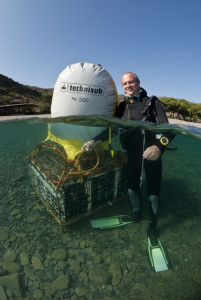
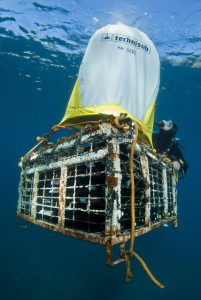 I jumped into the water and watched Jan lower the crate gently onto the seabed 10 metres below. Putting on my diving instructor hat for just one moment, this would be the perfect example for a lifting bag training course. Maybe there could be new PADI distinctive speciality in the midst? How about underwater wine diver? There were a few silvery bream watching the show and a startled scorpion fish darted out of the way just in the nick of time as the crate landed. Jan told me there were quite a lot of ‘teething troubles’ during the early stages of the project. The first batches were dropped to a depth of 20 metres but they found that the water pressure pushed the corks inside the bottles. Moving the crate into shallower water resolved this issue. A number of bottles were ruined by salt water seeping in through the corks so screw caps were fitted instead. But being made of metal they ended up going rusty. After some experimentation silicon corks and plastic sparkling wine corks turned out to be the best option. They also had problems distinguishing between the different wines due to the fact that the labels kept flaking off. Jan suggested a simple colour coded tagging system which seemed to work quite nicely.
I jumped into the water and watched Jan lower the crate gently onto the seabed 10 metres below. Putting on my diving instructor hat for just one moment, this would be the perfect example for a lifting bag training course. Maybe there could be new PADI distinctive speciality in the midst? How about underwater wine diver? There were a few silvery bream watching the show and a startled scorpion fish darted out of the way just in the nick of time as the crate landed. Jan told me there were quite a lot of ‘teething troubles’ during the early stages of the project. The first batches were dropped to a depth of 20 metres but they found that the water pressure pushed the corks inside the bottles. Moving the crate into shallower water resolved this issue. A number of bottles were ruined by salt water seeping in through the corks so screw caps were fitted instead. But being made of metal they ended up going rusty. After some experimentation silicon corks and plastic sparkling wine corks turned out to be the best option. They also had problems distinguishing between the different wines due to the fact that the labels kept flaking off. Jan suggested a simple colour coded tagging system which seemed to work quite nicely.
 The bottles are left on the seabed for a period of around 6 months. Xavier told me that this was all guess work and it just happened that 6 months was okay. I visited Cala Joncols at the end of October so this particular crateful would spend the entire winter period right through to spring 2013 submerged underwater. There are several environmental factors affecting the wine bottles. Under standard factory controlled conditions red wine is stored at a constant temperature of around 14 degrees and white wine between 6 to 10 degrees. But the sea temperature in Cala Joncols bay drops to around 11 or 12 degrees in the winter and then steadily rises to a high of 19 or 20 degrees in the summer months. Weather conditions i.e. waves and surge will also disturb the bottles where normally there wouldn’t be any movement at all.
The bottles are left on the seabed for a period of around 6 months. Xavier told me that this was all guess work and it just happened that 6 months was okay. I visited Cala Joncols at the end of October so this particular crateful would spend the entire winter period right through to spring 2013 submerged underwater. There are several environmental factors affecting the wine bottles. Under standard factory controlled conditions red wine is stored at a constant temperature of around 14 degrees and white wine between 6 to 10 degrees. But the sea temperature in Cala Joncols bay drops to around 11 or 12 degrees in the winter and then steadily rises to a high of 19 or 20 degrees in the summer months. Weather conditions i.e. waves and surge will also disturb the bottles where normally there wouldn’t be any movement at all.
Judging by my calculations 300 bottles of wine at approximately 18 – 25 euro per bottle is around the 7,000 euro mark. So this works out to be a substantial investment. Jan said that last year they nabbed some sneaky divers trying to steal the whole crate off the seabed. As a deterrent Jan has fitted a lock and chain, which is connected to a large concrete base. They also removed the marker buoy from the surface so the wine was harder to find.
In February 2010 Cala Joncols hotel hosted a big wine tasting event. Experts from all over Spain were invited as well as members of the media. After much gurgling and spitting the underwater wines received a mixed response. Some liked the taste and others were not so enamoured. The reds fared well. The Cava’s – white and rose – were voted the best.
On my last non-diving day before flying back home I decided to visit the Espelt vineyard for my own personal wine tasting afternoon (Euro Divers regularly arrange visits for divers). They offer a full tour of the factory followed by the all important sampling session. I tried a number of reds, whites and sparkling varieties from the underwater batches and the standard processes (and still managed to walk out afterwards!) I found that the underwater wines definitely had a distinct taste. Xavier seemed to think that the wine aged faster underwater. Apart from the cork problem the difference in depth/pressure shouldn’t have any effect on the wine as it’s in a sealed glass bottle. So the fluctuating temperature and the water movement must be the 2 residing factors that change the taste.
The whites and reds cost 18 euro a bottle and the Cava is 25 euro. All the wines are around 14 percent proof. Xavier said “we are not looking to sell this wine to a wider market.” So for now the only place you can buy a bottle of especial vino subacuatico is at Cala Joncols hotel. For the past 2 years they have only sunk 300 bottles each year but the wines popularity is growing fast. To be honest I’m not sure whether this is due to the novelty factor or down to the taste of the wine itself. Xavier concluded “we’re just having some fun.”
To find out more about Euro-Divers Spain, visit www.euro-divers.com/diving/diving-spain.
To find out more about Cala Joncols Hotel, visit www.calajoncols.com.
Discuss this article in the Scubaverse Forum.
Gear News
Introducing the TR-80, IR-50 and CS-30 Regulators from DYNAMICNORD

Whether you are a beginner or a professional diver – with the three new main regulators from DYNAMICNORD, everyone will find their favourite regulator. They all look super stylish.
Excellent performance with the TR-80
Quality and performance are the be-all and end-all for regulators. It is not for nothing that the TR stands for Tec Reg. The innovative design of the TR-80 guarantees absolute reliability – even in ice-cold waters.

Perfect breathing effort at 0.8 J/l / certified for diving in waters below 10 degrees / structural design made of solid brass for best cold protection / membrane-compensated design with dry seal of the first stage / reduced exhalation effort thanks to optimized exhalation membrane and bubble deflector / adjustable Venturi (dive/predive) and adjustment knob for individual inhalation comfort / innovative design of the front cover prevents free-flow in strong currents or when diving with scooters / design made of sandblasted brass, matt chrome finish / 2 HP and 4 LP outlets / mouthpiece made of high-quality, anti-allergic silicone for maximum comfort.


Amazing underwater adventures with the IR-50
The IR-50 is the top regulator for advanced and experienced divers. Natural breathing is the essence of this regulator.

Ideal breathing effort at 0.8 J/l /certified for diving in waters below 10 degrees / compensated membrane / adjustable venturi (dive/predive) and adjustment knob for individual inhalation comfort/ outlet valve and deflector for minimum exhalation effort and reduction of bubbles on the face / design made of sandblasted brass, matt chrome finish / 2 HP and 4 NP outlets / mouthpiece made of high-quality, anti-allergic silicone for maximum comfort.


The Workhorse – our CS-30
For diving centres and diving beginners – the workhorse stands for strong construction, reliability and robustness. Perfect for your training.

Optimal breathing effort at 0.8 J/l /recommended for diving in waters above 10 degrees / non-compensated piston / adjustable venturi (dive/predive) / outlet valve and deflector for minimum exhalation effort and reduction of bubbles on the face / design made of sandblasted brass, matt chrome finish / 1 HP and 3 NP outlets / mouthpiece made of high-quality, anti-allergic silicone for maximum comfort.


Octopus OP-30
The OP-30 is the ideal addition to all DYNAMICNORD regulators. It is identical in construction to the CS-30.

The TR-80, IR-50, CS-30 (DIN & INT) regulators and the Octopus OP-30 are available from DYNAMICNORD dealers and in the online store.
DYNAMICNORD – Your Outdoor Companion.
Marine Life & Conservation
Paul Watson Released as Denmark Blocks Japan’s Extradition Bid

Renowned anti-whaling activist Paul Watson has been released from custody in Greenland after spending five months in detention. Denmark’s Justice Ministry rejected Japan’s request for his extradition, citing insufficient guarantees that his time already served in custody would be credited against any potential sentence.
The 74-year-old Canadian-American was arrested on July 21 in Nuuk, Greenland’s capital, when his ship docked to refuel. His arrest was based on a 2012 Japanese warrant related to a 2010 encounter in Antarctic waters. Japan alleged Watson obstructed operations and caused damage to a whaling research ship during efforts to disrupt illegal whaling. Watson has consistently denied these claims, maintaining his commitment to marine conservation.
Denmark, which oversees extradition matters for Greenland, concluded that while the legal conditions for extradition were met, the lack of assurances from Japan regarding time-served credit made extradition untenable.
In a video shared by his foundation, Watson expressed gratitude and relief, saying, “After five months, it’s good to be out… and good to know they’re not sending me to Japan.” He added that the most difficult part of his time in custody was being separated from his two young sons.
Watson is a pioneering figure in marine conservation, known for founding the Captain Paul Watson Foundation in 2022 after decades of activism with the Sea Shepherd Conservation Society. His bold efforts to defend marine life have earned him widespread support, including from celebrities and conservationists. His work has also been featured in the acclaimed reality TV series Whale Wars.
Watson’s lawyer, Jonas Christoffersen, praised the decision, stating, “We are happy and relieved that Paul Watson is now free.” He added that Watson is eager to reunite with his family and continue his vital work.
The arrest occurred while Watson’s vessel, the M/Y John Paul DeJoria, was en route to the North Pacific with a team of 26 volunteers to intercept a Japanese whaling ship. His foundation described the arrest as politically motivated and emphasized that Watson’s actions were focused on ending illegal whaling practices.
Japan resumed commercial whaling in 2019 after leaving the International Whaling Commission, asserting that whale meat is a cultural tradition. Conservationists, however, continue to challenge these practices, highlighting their impact on marine ecosystems.
Despite the challenges, Watson remains steadfast in his mission to protect marine life and bring attention to whaling practices. His dedication to ocean conservation has made him a globally respected advocate for the environment.
-

 News2 months ago
News2 months agoIconic SS United States to become the World’s Largest Artificial Reef
-

 News3 months ago
News3 months agoBook Review – 52 Assignments: Underwater Photography
-

 Gear News3 months ago
Gear News3 months agoDYNAMICNORD – New German diving brand enters the British market
-

 News3 months ago
News3 months agoExploring Cenote El Pit: A Diver’s Dream
-

 Gear News3 months ago
Gear News3 months agoTry BARE drysuits (and maybe even win one!) this Friday with Sea & Sea at North West Dive Fest
-

 Marine Life & Conservation3 months ago
Marine Life & Conservation3 months agoBook Review: Coral Triangle Cameos
-

 Blogs2 months ago
Blogs2 months agoDive the Egyptian Red Sea this Autumn with Regaldive
-

 News3 months ago
News3 months ago2024 Ocean Art Underwater Photo Competition Announced




